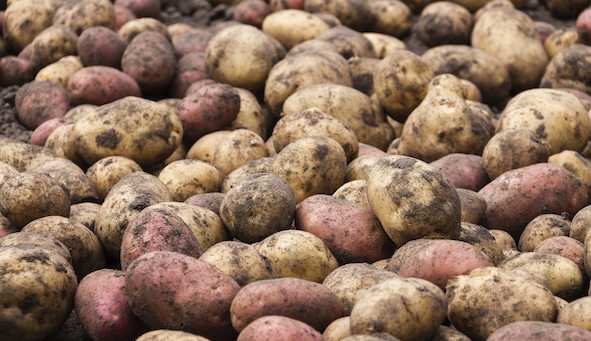By now, potatoes in most of the U.S. and parts of Canada have been in storage one to two months. The crop is at or nearing holding temperatures specific to the cultivar and use. Storages are being monitored for disease development, desired temperature, ventilation and humidity.
What isn’t as easy to see is the amount of weight loss, or shrinkage, that is occurring in storage.
Stored potatoes will lose weight from respiration (carbon and water loss), transpiration (direct water loss) and disease. Transpiration water loss is the greatest factor in weight loss unless high levels of disease are present – then that becomes the greatest contributor, especially if caused by any of the water rots.
Some of the factors that affect weight loss include cultivar, status of the tuber (e.g., skin set, stress, hydration level, pulp temperature, wounds/bruises, rate of wound healing), disease, sprouting, duration in storage and storage structure, management and conditions (temperature, humidity and ventilation). That is a long list of factors that contributes to weight loss and managing the complexity can be difficult, but knowing what contributes to the greatest weight loss of your crop can help minimize losses.
Unfortunately, the greatest weight loss has likely already happened – about the first 30 days in storage – and then it decreases as potatoes are held for the bulk of the storage season. The reason the first few weeks in storage result in the greatest weight loss is due to high rates of respiration, higher pulp and storage temperatures promoting greater transpiration water losses, and typically a greater vapour pressure deficit in trying to equilibrate the pile. Later in storage, there can be an increase in weight loss due to breaking of dormancy, a rise in storage temperatures and disease development.
In small-scale research trials, weight loss was dependent upon initial curing temperatures, and 55 to 70 per cent of the total weight loss occurred in the first 30 days. In general, about three per cent weight loss was seen in the first month. Total weight loss after five months was about five per cent.
Tuber conditions and early storage management can greatly affect initial weight loss. To get an idea of how much weight loss can be seen in commercial buildings, for the last several years the University of Idaho has put captured bags with 20 to 30 pounds of potatoes in various areas of the bulk pile. Number of bags per storage ranged from eight to 32. Each sample bag was weighed, and pulp temperatures determined as loaded into storage. The sample bags were re-weighed and evaluated for rot when the storage was unloaded. The difference in pre- and post-storage weights was the percent weight loss for the storage season. This is an easy way to estimate the overall weight loss and correlate field location, harvest conditions and storage management to weight loss in storage.
We found marginal weight loss differences between bags embedded in the pile versus bags placed on top of the pile. It is much easier to place bags on top of the pile, but they should not be placed on catwalks. Overall, conditions of the harvest day, field location, storage management and tuber conditions contributed to the weight loss potential in storage.
Having information on weight loss, even after the fact, can help identify ways to manage the crop in future years.
How do we minimize weight loss in storage during the remainder of the storage season? A few management options:
- Avoid fluctuations in temperature,
- Control disease and sprouting,
- Humidify incoming air, and
- Maintain a delta T (difference between top and bottom of pile) between 0.5 to 2 degrees Fahrenheit.
Winter with its cooler weather often brings higher outside relative humidity. Depending on which region potatoes are being stored, outside conditions may provide sufficient relative humidity, but in most locations, it is still insufficient to provide needed humidity. Colder air has a lower water content than warmer air – in other words, a lower absolute humidity. Humidifying outside air (evaporative cooling pads or supplemental humidifiers) will maintain a lower vapour pressure deficit around the potatoes.
Weight loss in storage is complex. Water loss is the major culprit, so focusing on proper hydration, skin set and pulp temperatures going into storage, along with managing early storage temperatures and equilibrating and minimizing the delta T extremes as soon as possible, and humidifying incoming air, will help with weight loss in storage.
Source: Nora Olsen and Mary Jo Frazier, University of Idaho











